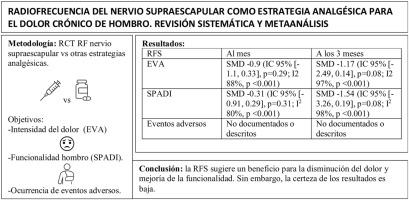肩胛上神经射频治疗作为慢性肩痛的镇痛策略。系统回顾和荟萃分析
IF 0.9
Q3 ANESTHESIOLOGY
Revista Espanola de Anestesiologia y Reanimacion
Pub Date : 2024-11-01
DOI:10.1016/j.redar.2024.03.004
引用次数: 0
摘要
导言:慢性肩痛在普通人群中发病率很高。目前已有许多不同的镇痛策略,包括肩胛上神经射频治疗(RFS);但是,这种方法的有效性仍不明确,也无法提出有力的建议。本系统性综述旨在分析最新的临床试验,评估应用于肩胛上神经的 RFS 技术在治疗慢性肩痛、术后功能和不良反应方面的有效性。我们纳入了将 RFS 与其他策略(包括安慰剂)进行比较的试验,这些试验的主要结果指标包括视觉模拟量表评定的疼痛、肩痛与残疾指数 (SPADI) 评定的功能以及不良反应的发生率。使用 Cochrane RoB2 工具分析了偏倚风险。使用随机效应模型对证据进行分析,并使用 I2 检验对异质性进行量化。结果我们确定了 3030 项试验,其中 8 项符合纳入标准(n = 408)。其中 7 项存在高偏倚风险。接受RFS治疗的患者在1个月和3个月时的疼痛强度较低,标准化平均差异(SMD)分别为-0.9(95% CI:-1.1-0.33;P=.29;I2 88%;P<;.001)和-1.17(95% CI:-2.49-0.14;P=.08;I2 97%;P<;.001)。接受RFS治疗的患者在1个月和3个月时的功能受损程度有所减轻,SMD分别为-0.31(95% CI:-0.91-0.29;P=.31;I2 80%;P<;.001)和-1.54(95% CI:-3.26-0.19;P=.08;I2 98%;P<;.001)。结论有证据表明,RFS可减轻疼痛并改善功能。然而,证据的确定性较低。本文章由计算机程序翻译,如有差异,请以英文原文为准。

Radiofrecuencia del nervio supraescapular como estrategia analgésica para el dolor crónico de hombro. Revisión sistemática y metaanálisis
Introduction
Chronic shoulder pain is highly prevalent in the general population. Many different analgesic strategies have been described, including radiofrequency treatment to the suprascapular nerve (RFS); however, the effectiveness this approach remains unclear, and no strong recommendation can be made. The aim of this systematic review is to analyse the latest clinical trials evaluating the effectiveness of RFS techniques applied to the suprascapular nerve in terms of management of chronic shoulder pain, post-procedural functionality, and adverse effects.
Methods
We performed a systematic review of clinical trials retrieved from Medline, Embase and the cCentral databases. We included trials comparing RFS with other strategies, including placebo, that had as their primary outcome measures pain rated on a visual analogue scale, functionality rated on a shoulder pain and disability index (SPADI), and the incidence of adverse events. Risk of bias was analysed using the Cochrane RoB2 tool. Evidence was analysed using a random effects model and heterogeneity was quantified using the I2 test.
Results
We identified 3030 trials, of which 8 met the inclusion criteria (n = 408). Seven had a high risk of bias. Pain intensity at 1 and 3 months was lower in patients receiving RFS, with a standardised mean difference (SMD) of −0.9 (95% CI: −1.1-0.33; P=.29; I2 88%; P<.001) and −1.17 (95% CI: −2.49-0.14; P=.08; I2 97%; P<.001), respectively. Functional compromise at 1 and 3 months decreased in patients receiving RFS, with an SMD of -0.31 (95% CI: −0.91-0.29; P=.31; I2 80%; P<.001) and −1.54 (95% CI: −3.26-0.19; P=.08; I2 98%; P<.001), respectively. No RFS-related adverse events were described.
Conclusion
The evidence suggests that RFS reduces pain and improves functionality. However, the certainty of the evidence is low.
求助全文
通过发布文献求助,成功后即可免费获取论文全文。
去求助
来源期刊

Revista Espanola de Anestesiologia y Reanimacion
ANESTHESIOLOGY-
CiteScore
1.80
自引率
15.40%
发文量
113
审稿时长
82 days
 求助内容:
求助内容: 应助结果提醒方式:
应助结果提醒方式:


